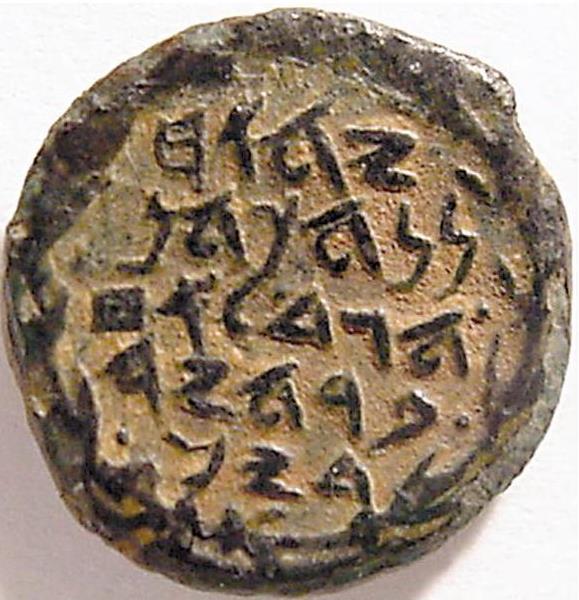First Jewish Coin From Jerusalem, 130 BCE
Material-Bronze
Denomination- Prutah
Size-1/2 inch in diameter
First Jewish Coin from Jerusalem – Obverse
The coin shown here is the first coin to be minted by a Jewish government in Jerusalem. Issued by John Hyrcanus I, the High Priest (the title used by the highest governing Hasmonean authority at the time), it evokes the glories of ages past. (The name Hasmonean comes from an ancestor of Mattathias.) The coin was worth one prutah; a loaf of bread cost ten prutot. The obverse bears a legend in paleo-Hebrew script, the script used before the Babylonian destruction of Jerusalem in 586 BCE. It reads- “Yehohanan [John] the High Priest and the Council of the Jews.” The use of pre-Exilic (before the Babylonian Exile) script was deliberately anachronistic, hearkening back to the days of Israel’s glory.
On the reverse, in between the horns of a double cornucopia (the “horn of plenty,” a fertility symbol taken from Greek iconography), a small pomegranate can be seen. The pomegranate, also a fertility symbol because of its many seeds, was regularly used as a design element in art and architecture, and dates back at least to the time of Solomon’s Temple- “There were two hundred pomegranates in rows all round [the capitals of the Temple],” according to 1 Kings 7-20. The only surviving object that may have come from the First Temple is an inscribed ivory pomegranate, which served as the head of a priest’s staff.
“Spending Your Way Through Jewish History,” BAR May-Jun 2003.






I am interested in the origin and the development of Hebrew alphabet script from the earliest script on coins and ostracons.
I would appreciate more information on the above-mentioned fields.
Sincerely,
mina kuttner
Dr. M. Kuttner
15 scott Dr.
Richmond Hill/ Ontario
Canada/ L4C 6V5
I am interested in the origin and the development of Hebrew alphabet script from the earliest script on coins and ostracons.
I would appreciate more information on the above-mentioned fields.
Sincerely,
mina kuttner
e-mail: emkuttner@bell.net
Dr. M. Kuttner
15 scott Dr.
Richmond Hill/ Ontario
Canada/ L4C 6V5
Could you be so kind and send me more ostracons and coins with paleo-Hebrew script.
many thanks,
mina
PS How could I get in touch with you via the phone for prescription?
Dr. Mina Kuttner
15 Scott Dr./Richmond Hill
Ontario/Canada
L4C 6V5